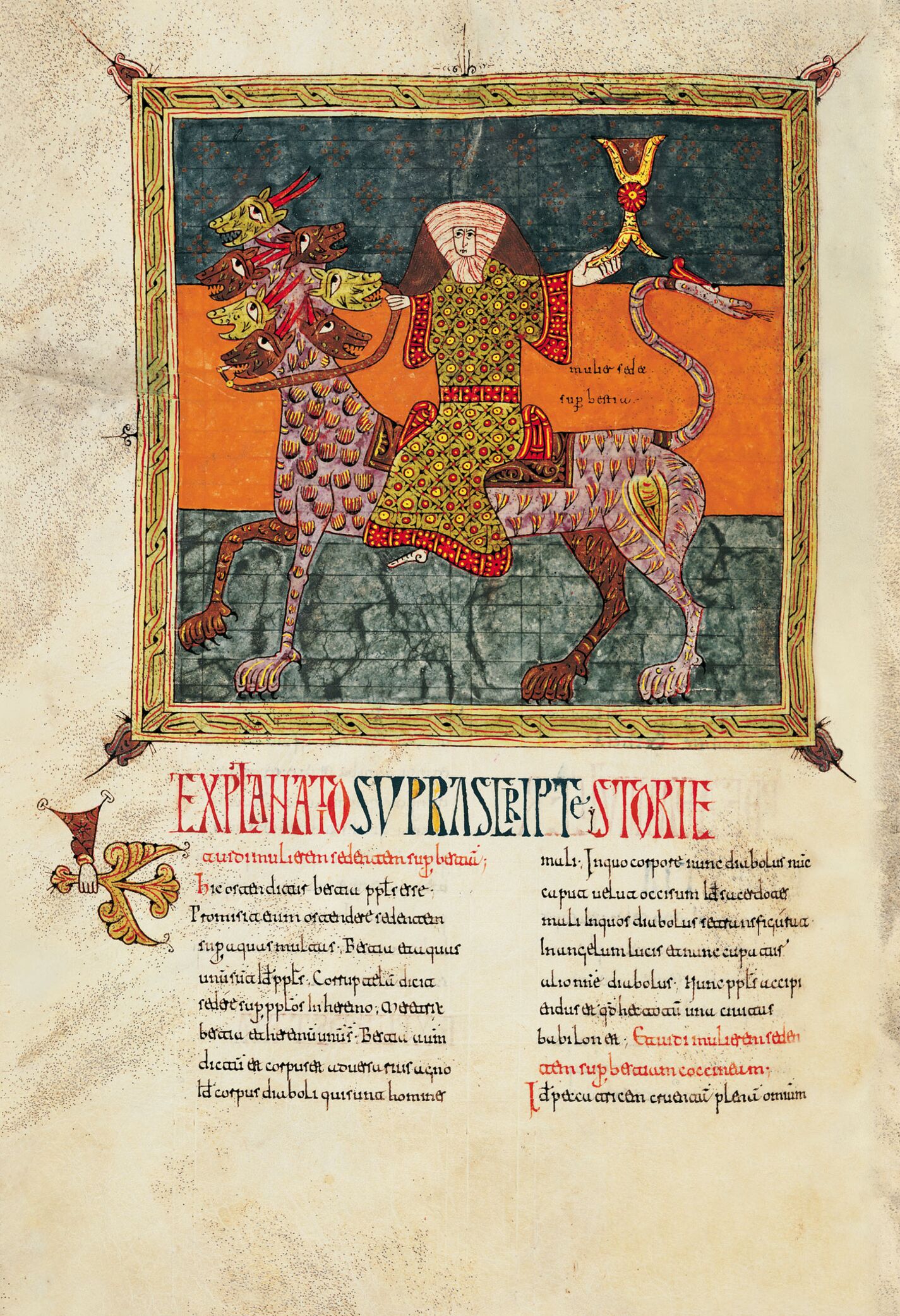This miniature is missing from the Morgan Beatus but can still be seen in Valcavado (f. 161v), Seu d’Urgell (f. 168v), Ferdinand I (f. 225v) and Silos, suggesting that Maius’ Beatus – which revolutionised the illustration of Beatus codices – must have contained it originally. The composition in Girona (f. 209r) showing the beast facing right, is different from the others which depict it facing the other way. All the codices show the woman barefoot although we can only suppose this is the case in the Silos Beatus since, as often occurred, her feet are shown in a rather artificial manner making it unclear whether they are shod or not. The lavishly attired rider in the Silos Beatus is depicted sitting side-saddle and facing forward. Her jewellery of gold, pearls and precious gems is suggested by her long gown decorated with rhombuses and trimmed with bands decorated with the same motif. Upon her head is a large, ribbed headdress reminiscent of Egyptian headdresses with the sides hanging down. This coif is different from those in the Valcavado, Urgell and Ferdinand I codices which emphasise the Islamic aspect in a negative sense. Once again, this garb reveals that inspiration was provided by a different Beatus, as can also be deduced by the textual peculiarity mulier sedet sup[er] bestia, instead of ubi mulier sedet sup[er] bestia. Like the other manuscripts, the name – Misterio – written on the woman’s forehead is not mentioned in the text. She grasps the beast’s reins in her right hand whilst holding the cup of abominations aloft in her left.
Although the text describes the beast as being reddish in colour, it is violet here and its skin is suggested by clusters of black, yellow and red lines. Its legs end in huge claws, with those on the right being darker. Some of its seven heads of different colours have one horn and others two, giving a total of ten horns. The seven heads are seven mountains and seven kings. The horns are also ten kings who have no kingdom yet. No mention is made of the blasphemous names given in the text either.
Situated beneath the illustration is the text which opens with an initial E[t uidi mulierem...] that accurately reproduces the structure of a human hand holding a branch with two developed foliate motifs and a palm leaf extending into another, smaller one on the opposite side. Yellow with red stripes.

This miniature is missing from the Morgan Beatus but can still be seen in Valcavado (f. 161v), Seu d’Urgell (f. 168v), Ferdinand I (f. 225v) and Silos, suggesting that Maius’ Beatus – which revolutionised the illustration of Beatus codices – must have contained it originally. The composition in Girona (f. 209r) showing the beast facing right, is different from the others which depict it facing the other way. All the codices show the woman barefoot although we can only suppose this is the case in the Silos Beatus since, as often occurred, her feet are shown in a rather artificial manner making it unclear whether they are shod or not. The lavishly attired rider in the Silos Beatus is depicted sitting side-saddle and facing forward. Her jewellery of gold, pearls and precious gems is suggested by her long gown decorated with rhombuses and trimmed with bands decorated with the same motif. Upon her head is a large, ribbed headdress reminiscent of Egyptian headdresses with the sides hanging down. This coif is different from those in the Valcavado, Urgell and Ferdinand I codices which emphasise the Islamic aspect in a negative sense. Once again, this garb reveals that inspiration was provided by a different Beatus, as can also be deduced by the textual peculiarity mulier sedet sup[er] bestia, instead of ubi mulier sedet sup[er] bestia. Like the other manuscripts, the name – Misterio – written on the woman’s forehead is not mentioned in the text. She grasps the beast’s reins in her right hand whilst holding the cup of abominations aloft in her left.
Although the text describes the beast as being reddish in colour, it is violet here and its skin is suggested by clusters of black, yellow and red lines. Its legs end in huge claws, with those on the right being darker. Some of its seven heads of different colours have one horn and others two, giving a total of ten horns. The seven heads are seven mountains and seven kings. The horns are also ten kings who have no kingdom yet. No mention is made of the blasphemous names given in the text either.
Situated beneath the illustration is the text which opens with an initial E[t uidi mulierem...] that accurately reproduces the structure of a human hand holding a branch with two developed foliate motifs and a palm leaf extending into another, smaller one on the opposite side. Yellow with red stripes.